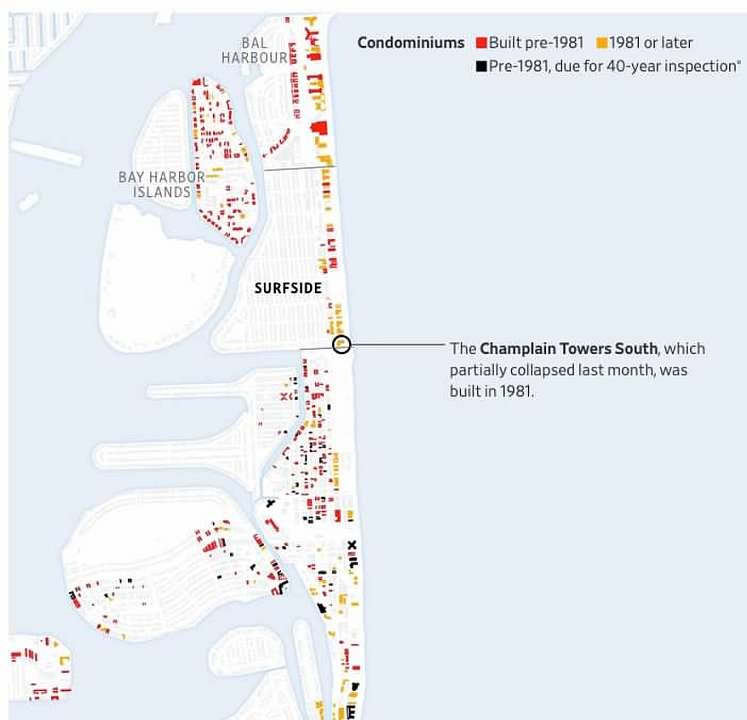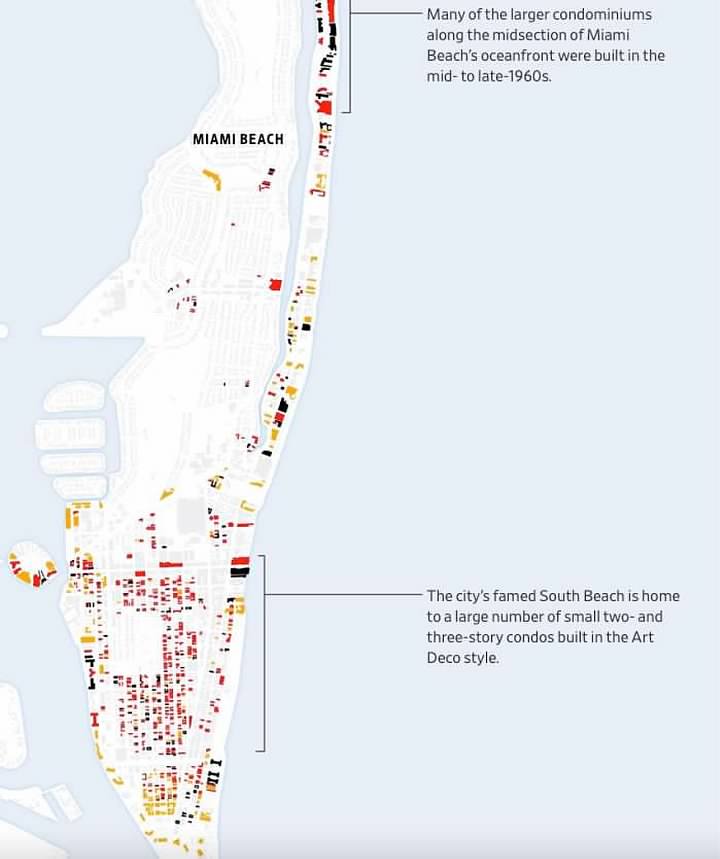| |
 Posted Jul 14, 2021, 8:49 PM
Posted Jul 14, 2021, 8:49 PM
|
 |
Registered User
|
|
Join Date: Dec 2016
Location: San Francisco
Posts: 24,177
|
|
|
Two-Thirds of Miami Condo Buildings Are Older Than 30 Years. Repair Bills Are Due
Quote:
By Laura Kusisto, Jon Kamp and Daniela Hernandez / Photographs by Maria Alejandra Cardona for The Wall Street Journal
July 14, 2021 10:09 am ET
Engineers say it can take just 30 years for condominium buildings to reach a point when owners can no longer delay making critical repairs.
In the Miami region, two out of every three condo buildings are more than 30 years old, according to data compiled by real-estate data firm Zillow for The Wall Street Journal. In at least seven other Florida cities, some three-quarters of condo buildings have hit that age.
Many of the aging towers line the beachfront, where salt corrosion and other forces are speeding their decline. That is leaving thousands of buildings saddled with multimillion-dollar repair costs—and little notion of how to pay for them . . . .
It often takes as little as 20 years for many building materials, including stucco, windows and shingles, to reach the end of what engineers and building inspectors call their “useful life”—industry jargon for materials that need replacement or significant repair.
Nationwide, more than half of all condo buildings have stood at least three decades, according to Zillow. Coastal cities have among the largest shares of such aging buildings. In Miami, nearly 40% of the housing stock is condos, the highest of any major metropolitan area in the U.S., according to Zillow.
Building inspectors must approve most condo buildings before the first residents move in, but oversight after that is limited in most U.S. counties . . . .
For condo towers with decades of deferred maintenance, the cost to repair leaking roofs, cracking concrete pillars and listing balconies can reach millions of dollars, an amount that few buildings have on hand, construction attorneys and structural engineers said. Shortly before Champlain Towers South collapsed, the board president told residents that costs for needed repairs, including concrete restoration work, had reached more than $15 million . . . .
The 11-story Manatee condo building in Surfside, Fla., struggled to reach a consensus over how to pay for major repairs a few years ago. It was built in 1974, during the Florida condo boom of the 1970s and 1980s.
Miami-Dade County requires a building inspection after 40 years. When the Manatee approached that milestone in 2014, it needed millions of dollars of work. That included fixing storm doors, electrical systems and corrosion.
At first, the project was budgeted for roughly $3.5 million, said Ira Kirschner, a 77-year-old retired accountant, who served on the condo’s board for 12 years. By the end, the figure had ballooned to nearly $7 million, he said. His share for his ninth floor unit was $47,500.
The building spent about five years on those repairs, with persistent pushback from residents about extra fees and the necessity of certain fixes, said Nelson Castellanos, who served on the board during that time. “Suddenly everyone thought they were a structural engineer,” said Mr. Castellanos, a retired highway engineer.
Former board members say the major repairs are now largely completed.
Florida law allows condo boards to waive a requirement in state law that they collect money from residents for potential future repairs. The Manatee voted for a number of years against keeping reserves.
Many of Florida’s buildings were built using concrete and rebar, a solid construction method that can stand for decades. To last, though, it requires diligent waterproofing during construction and afterward, which often wasn’t done in the early decades of the condo boom, according to Mr. Prichard, the construction lawyer.
Engineers and city officials who were around when Champlain Towers South, the Manatee and other similar buildings were built described a kind of Wild West atmosphere in which developers sometimes made late changes to the building design without consulting engineers. Local inspectors had limited training.
Construction jobs back then, unlike those today, weren’t required to have an expert known as a “threshold inspector” on site consistently, said Jaime Gascon, who directs the Board and Code Administration Division for Miami-Dade County’s Regulatory and Economic Resources Department. Those are experts hired by builders but who answer to local governments to make sure a building’s construction follows both the designs and the code.
A 1974 building collapse in downtown Miami inspired the requirement in Miami-Dade and Broward counties that buildings undergo an inspection once they reach 40 years, and that needed repairs be performed. John Pistorino, a structural engineer who was part of the team that evaluated that building collapse, spearheaded the 40-year recertification law.
That building, like Champlain Towers South, had problems with concrete deterioration.
“Our evaluation of that building was that it involved a deterioration of concrete because salt had gotten into the steel,” Mr. Pistorino said of the 1974 collapse during a presentation last week to concerned members of various condo boards. “The concrete then lost its capacity to hold.”
Florida now has among the strictest building codes in the country, enacted after Hurricane Andrew in 1992. There is no statewide requirement to reinspect buildings as they age.
In 2008, a special legislative committee formed by then-Florida House Speaker Marco Rubio, now a U.S. senator, led to legislation requiring any condo building taller than three stories to be inspected every five years. But a provision allowed condo owners to vote to exempt their buildings from that requirement. Lawmakers repealed the requirement altogether in 2010 as the state and country were emerging from the housing crash . . . .
There are limits to how much regulators can do to force condo associations to perform repairs on their own properties, absent evidence that they are structurally unsafe. Increasing inspection and repair requirements can burden retirees on fixed incomes, who make up a significant portion of residents in such aging Florida buildings, and lower-income owners.
Condo owners pay monthly maintenance fees that are supposed to cover common expenses such as taxes and everyday maintenance of shared areas. Engineers and board members say they sometimes face ferocious pushback when they have to persuade condo residents to pay extra for repairs to problems that may not become an issue in their lifetimes . . . .


|
https://www.wsj.com/articles/miami-c...d=hp_lead_pos5

|
|
|



